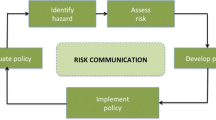Abstract
The intentional or unintentional introduction of a pathogen in an urban setting presents severe communication chanllenges. Risk communication—a science-based approach for communicating effectively in high-concern situations—provides a set of principles and tools for meeting those challenges. A brief overview of the risk communication theoretical perspective and basic risk communication models is presented here, and the risk communication perspective is applied to the West Nile virus epidemic in New York City in 1999 and 2000 and to a possible bioterrorist event. The purpose is to provide practical information on how perceptions of the risks associated with a disease outbreak might be perceived and how communications would be best managed.
Similar content being viewed by others
References
US General Accounting Office.West Nile Virus Outbreak: Lessons for Public Health Preparedness. Washington, DC: US Government Printing Office; 2000.
Covello VT, McCallum DB, Pavlova MT. Principles and guidelines for improving risk communication. In: Covello VT, McCallum DB, Pavlova MT, eds.Effective Risk Communication: the Role and Responsibility of Government and Nongovernment Organizations. New York: Plenum Press; 1989:3–16.
National Research Council,Improving Risk Communication, Washington, DC: National Academy Press; 1989.
Slovic P. Perception of risk.Science. 1987;236:280–285.
Covello VT. Risk perception, risk communication, and EMF exposure: tools and techniques for communicating risk information. In: Matthes R, Bernhardt JH, Repacholi MH, eds.Risk Perception, Risk Communication, and Its Application to EMF Exposure: Proceedings of the World Health Organization/ICNRP International Conference (ICNIRP 5/98). Vienna, Austria: International Commission on Non-Ionizing Radiation Protection; 1998:179–214.
Fischhoff B. Risk perception and communication unplugged: 20 years of progress.Risk Anal. 1995;15(2):137–145.
Covello VT, Sandman PM. Risk communication: evolution and revolution. In: Wolbarst A, ed.Solutions to an Environment in Peril, Baltimore, MD: John Hopkins University Press; 2001:164–178.
Sandman PM. 1989. Hazard versus outrage in the public perception of risk. In: Covello VT, McCallum DB, Pavlova MT, eds.Effective Risk Communication: the Role and Responsibility of Government and Nongovernment Organizations. New York: Plenum Press; 1989:45–49.
National Research Council.Understanding Risk: Informing Decisions in a Democratic Society. Washington, DC: National Academy Press; 1996.
Arkin EB. Translation of risk information for the public: message development. In: Covello VT, McCallum DB, Pavlova MT, eds.Effective Risk Communication: the Role and Responsibility of Government and Nongoverment Organizations. New York: Plenum Press; 1989:127–135.
Baron J, Hershey JC, Kunreuther H. Determinants of priority for risk reduction: the role of worry.Risk Anal. 2000;20(4):413–428.
Chess C, Salomone KL, Hance BJ, Saville A. Results of a national symposium on risk communication: next steps for government agencies.Risk Anal. 1995;15(2):115–125.
Burger J, Pflugh KK, Lurig L, Von Hagen LA, Von Hagen S. Fishing in urban New Jersey: ethnicity affects information sources, perception, and compliance.Risk Anal. 1999;19(2):217–229.
Elliot SJ, Cole DC, Krueger P, Voorberg N, Wakefield S. The power of perception: health risk attributed to air poplution in an urban industrial neighborhood.Risk Anal. 1999;19(2):621–633.
Grobe D, Douthitt R, Zepeda L. A model of consumers' risk perceptions toward recombinant bovine growth hormone (rbGH): the impact of risk characteristics.Risk Anal. 1999;19(4):661–673.
McBeth MK, Oakes AS. Citizen perception of risks associated with moving radiological waste.Risk Anal. 1996;16(3):421–427.
McDaniels TL, Gregory RS, Fields D. Democratizing risk management: successful public involvement in local water management decisions.Risk Anal. 1999;19(3):497–509.
Morgan G, Fischhoff B, Bostrom A, Lave L, Atman CJ. Communicating risk to the public.Environ Sci Technol. 1992;26(11):2048–2056.
Jasanoff S. Bridging the two cultures of risk analysis.Risk Anal. 1993;13(2):123–129.
Renn O, Levine D. Credibility and trust in risk communication. In: Kasperson R, Stallen P, eds.Communicating Risks to the Public. Dordrecht, The Netherlands: Kluwer Academic Publishers; 1991;175–218.
US Environmental Protection Agency.Public Knowledge and Perceptions of Chemical Risks in Six Communities: Analysis of a Baseline Survey. Washington, DC: US Government Printing Office; 1990.
Sjoberg L. Factors in risk perception.Risk Anal. 2000;20(1):1–11.
Weinstein ND. Why it won't happen to me: perceptions of risk factors and susceptibility.Health Psychol. 1984;3:431–457.
Nelkin D. Communicating technological risk: the social construction of risk perception.Annu Rev Public Health. 1989;10:95–113.
Rogers GO. The dynamics of risk perception: how does perceived risk respond to risk events?Risk Anal. 1997;17(6):745–757.
Wildavsky A, Dake K. Theories of risk perception: who fears what and why.Daedalus. 1990;112:41–60.
Renn O, Bums WJ, Kasperson JX, Kasperson RE, Slovic P. The social amplification of risk: theoretical foundations and empirical applications.J Soc Sci Issues. 1992;48: 137–160.
Fischhoff B. Helping the public make health risk decisions. In: Covello VT, McCallum DB, Pavlova MT, eds.Effective Risk Communization: the Role and Responsibility of Government and Nongovernment Organizations. New York: Plenum Press; 1989:111–116.
Johnson BB. “The mental model” meets “the planning process”: wrestling with risk communication research and practice.Risk Anal. 1993;13(1):5–8.
Wilson R, Crouch E. Risk assessment and comparisons: an introduction.Science. 1987; 236:267–270.
Neuwirth K, Dunwoody S, Griffin RJ. Protection motivation and risk communication.Risk Anal. 2000;20(5):721–733.
Maslow AH.Motivation and Personality. New York: Harper and Row; 1970.
Gould L, Walker C, eds.Too Hot to Handle. New Haven, CT: Yale University Press; 1982.
Slovic P. Trust, emotion, sex, politics, and science: surveying the risk-assessment battle-field.Risk Anal. 1999;19(4):689–701.
Peters RG, Covello VT, McCallum DB. The determinants of trust and credibility in environmental risk communication: an empirical study.Risk Anal. 1997;17(1):43–54.
New York City Department of Health.Comprehensive Arthropod-Borne Disease Surveillance and Control Plan 2000. New York: New York City Dept of Health; 2000.
National Research Council.Chemical and Biological Terrorism: Research and Development to Improve Civilian Medical Response. Washington, DC: National Academy Press; 1999.
Lederberg J.Biological Weapons: Limiting the Threat. Cambridge, MA: MIT Press; 1999.
Santos S, Covello VT, McCallum DB. Industry response to SARA Title III: pollution prevention, risk reduction, and risk communication.Risk Anal. 1996;16(1):57–65.
Lynn FM, Busenberg GJ. Citizen advisory committees and environmental policy: what we know, what's left to discover.Risk Anal. 1995;15(2):147–161.
Author information
Authors and Affiliations
Corresponding author
Rights and permissions
About this article
Cite this article
Covello, V.T., Peters, R.G., Wojtecki, J.G. et al. Risk communication, the West Nile virus epidemic, and bioterrorism: responding to the commnication challenges posed by the intentional or unintentional release of a pathogen in an urban setting. J Urban Health 78, 382–391 (2001). https://doi.org/10.1093/jurban/78.2.382
Issue Date:
DOI: https://doi.org/10.1093/jurban/78.2.382




